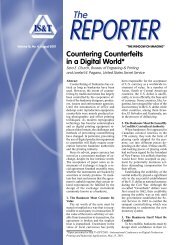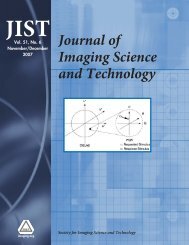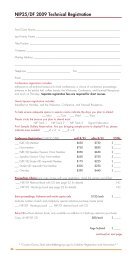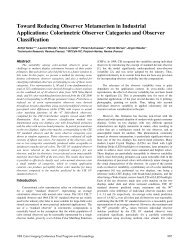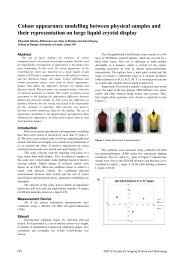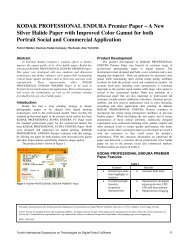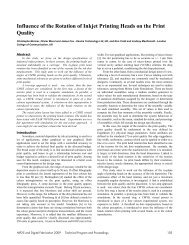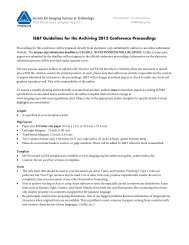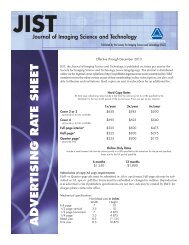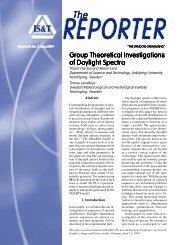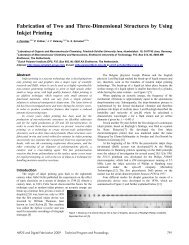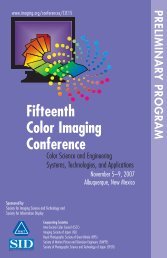JIST - Society for Imaging Science and Technology
JIST - Society for Imaging Science and Technology
JIST - Society for Imaging Science and Technology
Create successful ePaper yourself
Turn your PDF publications into a flip-book with our unique Google optimized e-Paper software.
Lee et al.: Digital color image halftone: Hybrid error diffusion using the mask perturbation <strong>and</strong> quality verification<br />
Figure 1. General block diagram of conventional error diffusion.<br />
sure between color images is also derived. Then, the simulation<br />
results of the algorithms are given with natural images.<br />
We also compare our algorithm with conventional methods<br />
using the objective assessment, halftone statistical analysis,<br />
<strong>and</strong> color image structural similarity measure. Finally, there<br />
is the Conclusion.<br />
CONVENTIONAL ERROR DIFFUSION ALGORITHM<br />
There are many error diffusion algorithms <strong>for</strong> improving the<br />
halftone quality. 1–12 Almost of the conventional algorithms<br />
are designed based on the Floyd–Steinberg error diffusion<br />
algorithm. In this section, we investigate the Floyd–Steinberg<br />
algorithm 1 <strong>and</strong> the Jarvice et al. 2 error diffusion algorithm,<br />
as a representative conventional error diffusion algorithm, to<br />
simulation results. In Figure 1, each signal can be defined as<br />
follows:<br />
=1, if jx,y T,<br />
bx,y 1<br />
0, otherwise,<br />
jx,y = ix,y − a jk ex − j,y − k,<br />
ex,y = bx,y − jx,y,<br />
2<br />
3<br />
Figure 2. Simulation results of conventional error diffusion algorithm.<br />
Figure 3. Block diagram of hybrid error diffusion.<br />
where ix,y is the input image <strong>and</strong> the bx,y is the output<br />
image of the halftone process. The signal jx,y represents<br />
the modified input, a jk are the error filter weights, a jk =1,<br />
<strong>and</strong> T is the threshold value. The signal ex,y is the accumulated<br />
error value that will be diffused to adjacent pixels.<br />
The conventional error diffusion algorithm has the advantage<br />
of simple implementation <strong>and</strong> fast calculation. However,<br />
the conventional error diffusion introduces the distortion<br />
that reduces image quality <strong>and</strong> produces worms, false<br />
textures, <strong>and</strong> additive noise. The simulation results of the<br />
Floyd–Steinberg error diffusion algorithm <strong>and</strong> the Jarvice et<br />
al. 2 error diffusion algorithm are given in Figure 2. The input<br />
image is the “gradation ramp” of increasing gray levels<br />
from 0 to 128 gray levels with the slope of 4 pixels per gray<br />
level. From the simulation results, we can see the prominent<br />
discontinuity <strong>and</strong> a white dot in the middle of the gradation.<br />
In the low gray area, we can also see diagonal stripes. The<br />
worm patterns are also in the middle of the gradation ramp.<br />
The reduction of these kinds of conventional artifacts is the<br />
objective of the proposed algorithm. At the end of this paper,<br />
we compare the results of conventional error diffusion<br />
to the results of the Floyd–Steinberg error diffusion, vector<br />
color error diffusion, 7 <strong>and</strong> Shiau–Fan error diffusion 10 with<br />
natural images.<br />
HYBRID ERROR DIFFUSION ALGORITHM<br />
We use the concept of perturbing error filter weight by using<br />
the mask value, which is perturbed with a pseudor<strong>and</strong>om<br />
number. The concept of the proposed hybrid error diffusion<br />
is shown in Figure 3, in which each signal can be defined as<br />
follows:<br />
=1, if jx,y T<br />
bx,y 4<br />
0, otherwise,<br />
jx,y = ix,y − ha jk ex − j,y − k,<br />
ex,y = bx,y − jx,y,<br />
Ma jk = MaskValue <strong>for</strong> each color/line/pixel ,<br />
ha jk = RndNum + Ma jk ,<br />
5<br />
6<br />
7<br />
8<br />
392 J. <strong>Imaging</strong> Sci. Technol. 515/Sep.-Oct. 2007




